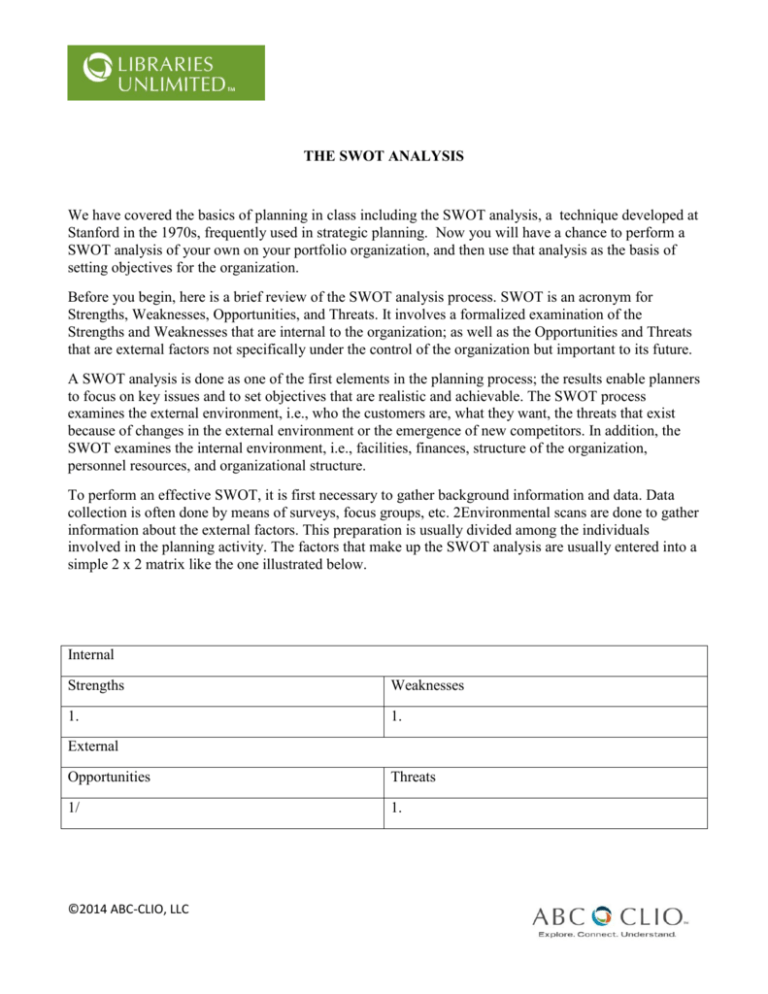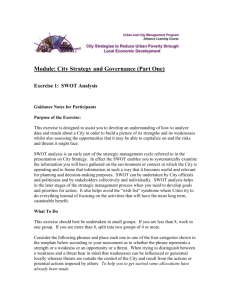THE SWOT ANALYSIS - ABC-Clio
advertisement

THE SWOT ANALYSIS We have covered the basics of planning in class including the SWOT analysis, a technique developed at Stanford in the 1970s, frequently used in strategic planning. Now you will have a chance to perform a SWOT analysis of your own on your portfolio organization, and then use that analysis as the basis of setting objectives for the organization. Before you begin, here is a brief review of the SWOT analysis process. SWOT is an acronym for Strengths, Weaknesses, Opportunities, and Threats. It involves a formalized examination of the Strengths and Weaknesses that are internal to the organization; as well as the Opportunities and Threats that are external factors not specifically under the control of the organization but important to its future. A SWOT analysis is done as one of the first elements in the planning process; the results enable planners to focus on key issues and to set objectives that are realistic and achievable. The SWOT process examines the external environment, i.e., who the customers are, what they want, the threats that exist because of changes in the external environment or the emergence of new competitors. In addition, the SWOT examines the internal environment, i.e., facilities, finances, structure of the organization, personnel resources, and organizational structure. To perform an effective SWOT, it is first necessary to gather background information and data. Data collection is often done by means of surveys, focus groups, etc. 2Environmental scans are done to gather information about the external factors. This preparation is usually divided among the individuals involved in the planning activity. The factors that make up the SWOT analysis are usually entered into a simple 2 x 2 matrix like the one illustrated below. Internal Strengths Weaknesses 1. 1. External Opportunities Threats 1/ 1. ©2014 ABC-CLIO, LLC SWOT analyses are usually performed by groups, and the process benefits from the multiple perspectives of a number of individuals who all bring different knowledge bases and outlooks to the activity. Often the analysis takes place in a brainstorming session. When performing a SWOT, a group should be as analytical and specific as possible. The planners should be honest and should not try to disguise weaknesses. They should also never lose sight of the external influences and trends. SWOT assessments are simple but powerful tools. They lead to realistic plans that are essential in order to take an organization from where it is today to where it wants to be tomorrow, because they examine both the internal and external environment and provide an action plan. As a result of the SWOT process, an organization has identified the: 3 • Strengths that need to be maintained, built upon, or leveraged. • Weaknesses that need to be remedied, changed, or stopped. • Opportunities that need to be prioritized, captured, built on, and optimized. • Threats that need to be countered or minimized and managed. Of course, the SWOT analysis is just the first step in the planning process. Once the plan has been made, it must be implemented, and after the implementation, it must beevaluated. Planning is never a one-shot process but a cycle. For your assignment for this class, you will not have the benefit of working with a group, or the advantage of having data collected especially for the process. You will work alone, with only your knowledge of your organization and what is available from public sources. (There is a SWOT analysis of Starbucks attached at the end of this document, if you would like an example of the type of SWOT that can be constructed under these conditions). Before you begin, you might want to look at a brief YouTube video on how to perform a SWOT. http://www.youtube.com/watch?v=GNXYI10Po6A Then, using the organization you wrote about in your first portfolio, perform your own SWOT analysis. ©2014 ABC-CLIO, LLC Complete the following activities. Activity 1 – Perform a SWOT analysis for your portfolio organization. Strengths: Weakness: Internal Opportunities: Threats: Externall You don’t have to enter your factors in a matrix, but can write them under the appropriate headings (see the Starbucks example below). Activity 2 – Decide on one goal you would like the organization to achieve in two years, and write a brief statement proposing a strategy for achieving that goal. Activity 3 – Write a brief statement describing how the proposed strategy will be implemented. When you have finished, send a copy of these three activities to me using the Digital Dropbox on Blackboard. Finally, post a brief comment on the class discussion board responding to the question about the uses of SWOTs in planning. Due date for this exercise: 5 pm, Wednesday, 9/22. If you have any questions about this assignment, send me an email and I will try to answer them. Sample SWOT Analysis of Starbucks I chose this example because most of us are familiar with Starbucks, and because it shows what can be done using only publicly available information. This analysis was adapted from one found in Marketing Teacher (an online source designed to help people learn more about marketing: http://marketingteacher.com/ ). The analysis is a bit out of date but still useful. I think the weakest quadrant in this analysis is the “weaknesses.” Organizations do not usually publicly disclose their weaknesses, and it takes insider information to be able to identify the most important factors in this area. ©2014 ABC-CLIO, LLC This SWOT also lacks factors in the “strengths” area that would be there if the analysis had been done by insiders. However, this example is a good one in terms of showing some of the elements that I would like you to look for, and it is about the length I would expect in your own SWOT. Because (I hope) you have some inside knowledge of your organization, you should be able to draw on more than publicly available information. SWOT Analysis of Starbucks Strengths Starbucks Corporation is a very profitable organization, earning in excess of $600 million in 2004. The company generated revenue of more than $5 billion in the same year. It is a global coffee brand built upon a reputation for fine products and services. It has almost 9,000 cafes in almost 40 countries. Starbucks was one of the Fortune Top 100 Companies to Work For in 2005. The company is a respected employer that values its workforce.5 The organization has strong ethical values and an ethical mission statement as follows: “Starbucks is committed to a role of environmental leadership in all facets of our business.” Weaknesses Starbucks has a reputation for new product development and creativity. However, the company remains vulnerable to the possibility that its innovation may falter over time. The organization has a strong presence in the United States of America, with more than three quarters of its cafes located in the home market. It is often argued that Starbucks needs to look for a portfolio of countries, in order to spread business risk. The organization is dependent on a main competitive advantage, the retail sales of coffee. This could make them slow to diversify into other sectors should the need arise. Opportunities Starbucks is very good at taking advantage of opportunities. In 2004, with Hewlett Packard, the company created a CD-burning service in its Santa Monica, California, cafe, where customers can create their own music CDs. New products and services can be retailed in their cafes, such as Fair Trade products. The company has the opportunity to expand its global operations. New markets for coffee, such as India and the Pacific Rim nations, are beginning to emerge. Co-branding with other manufacturers of food and drink, and brand franchising to manufacturers of other goods and services both have potential. ©2014 ABC-CLIO, LLC Threats Who knows if the market for coffee will grow and stay in favor with customers, or whether another type of beverage or leisure activity will replace coffee in the future? The economic downturn has caused people to economize by cutting back on expensive coffee drinks. Starbucks is exposed to rises in the cost of coffee and dairy products. Since its 1971 inception in Pike Place Market, in Seattle, Washington, Starbucks's success has led to the market entry of many competitors and copycat brands that pose potential threats. ©2014 ABC-CLIO, LLC THE SWEET SMELL OF FAILURE: STRATEGIC PLANNING AND KRISPY KREME DONUTS Krispy Kreme donuts were first sold in Winston Salem, NC in the 1930s. The brand became hugely popular all over the Southeast and in the 1990s the company began to expand nationwide. The price of the company stock rose quickly as people across the country a begin to line up to buy hot Krispy Kreme donuts. But investors soon found out that Krispy Kreme Doughnuts' shares were just like its doughnuts: Get them while they're hot because they can go stale in a hurry. K rispy Kreme was the second-best performing initial public offering of 2000, according to calculations by Bloomberg. The price of the stock had jumped eightfold, to $44.59, by the summer of 2003, a price that was more than 50 times the company's profits but then the stock price began to plummet and it now sells for a fraction of what it cost when Fortune magazine proclaimed Krispy Kreme "the hottest brand in America." Recently, the stock closed at $8.41. The company expanded too fast, and the Krispy Kreme mystique was lost when the stores began to become ubiquitous. Other factors also are affecting this organization. Gasoline prices have gotten so high that people are no longer willing to drive to the doughnut shop. Increasing fuel costs also driving up the company's transportation costs and driving down profits. Doughnut sales in grocery stores are falling, too, because the supermarket chains that sell Krispy Kremes are losing shoppers to Wal-Mart. And,to add the icing to the cake (or the donut) all the low-carb diets have also caused people to give up doughnuts. A Krispy Kreme spokeswoman said that the company had been hit by a "perfect storm" of higher gas prices, low carbs, competition from Wal-Mart and overheated growth. "Any one of them individually, we could have dealt with," she said. You have been hired as a consultant to help Krispy Kreme develop a strategic plan to turn around their losses. What would a SWOT analysis show? What problems should be addressed first? How should this company change it strategy to be more successful? Written by Barbara B. Moran ©2014 ABC-CLIO, LLC




